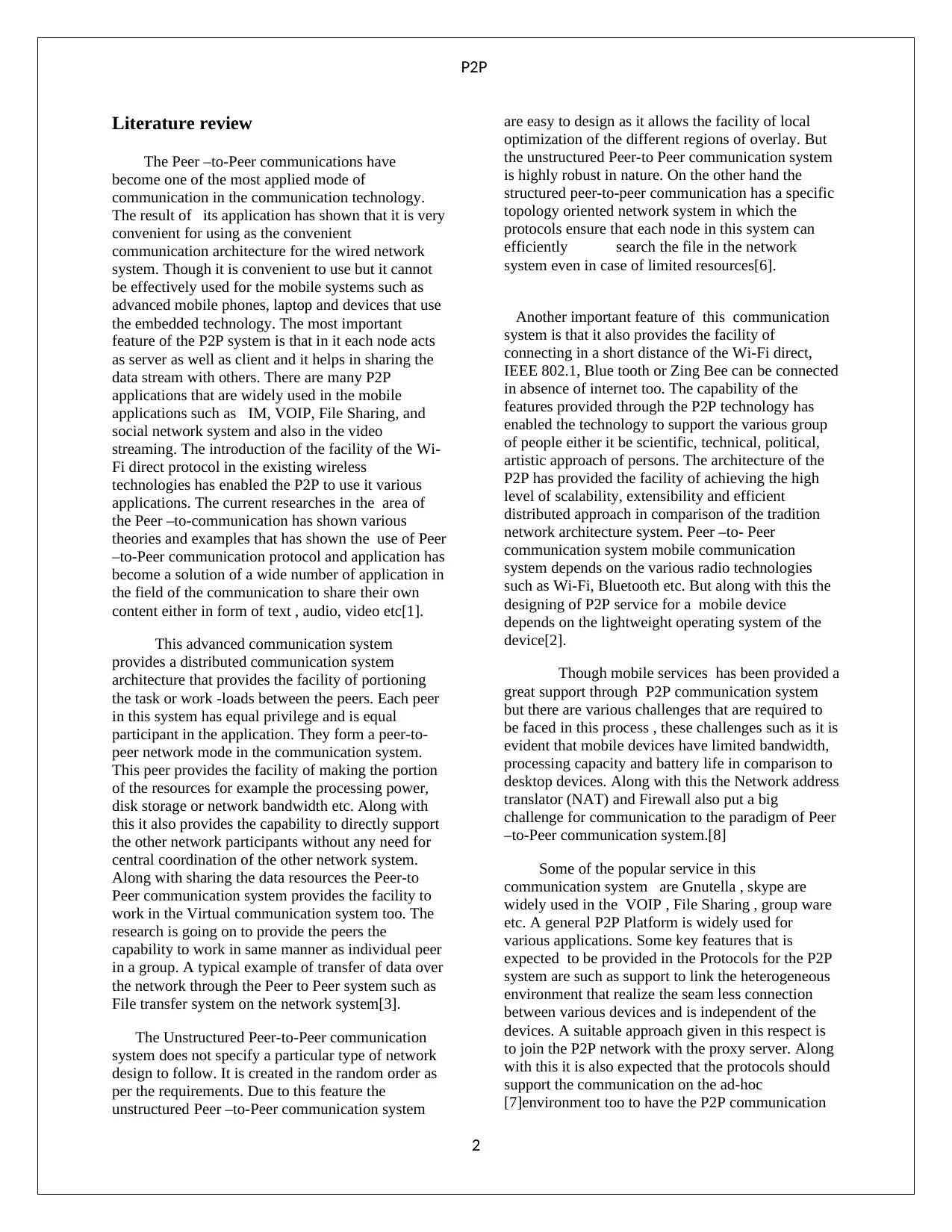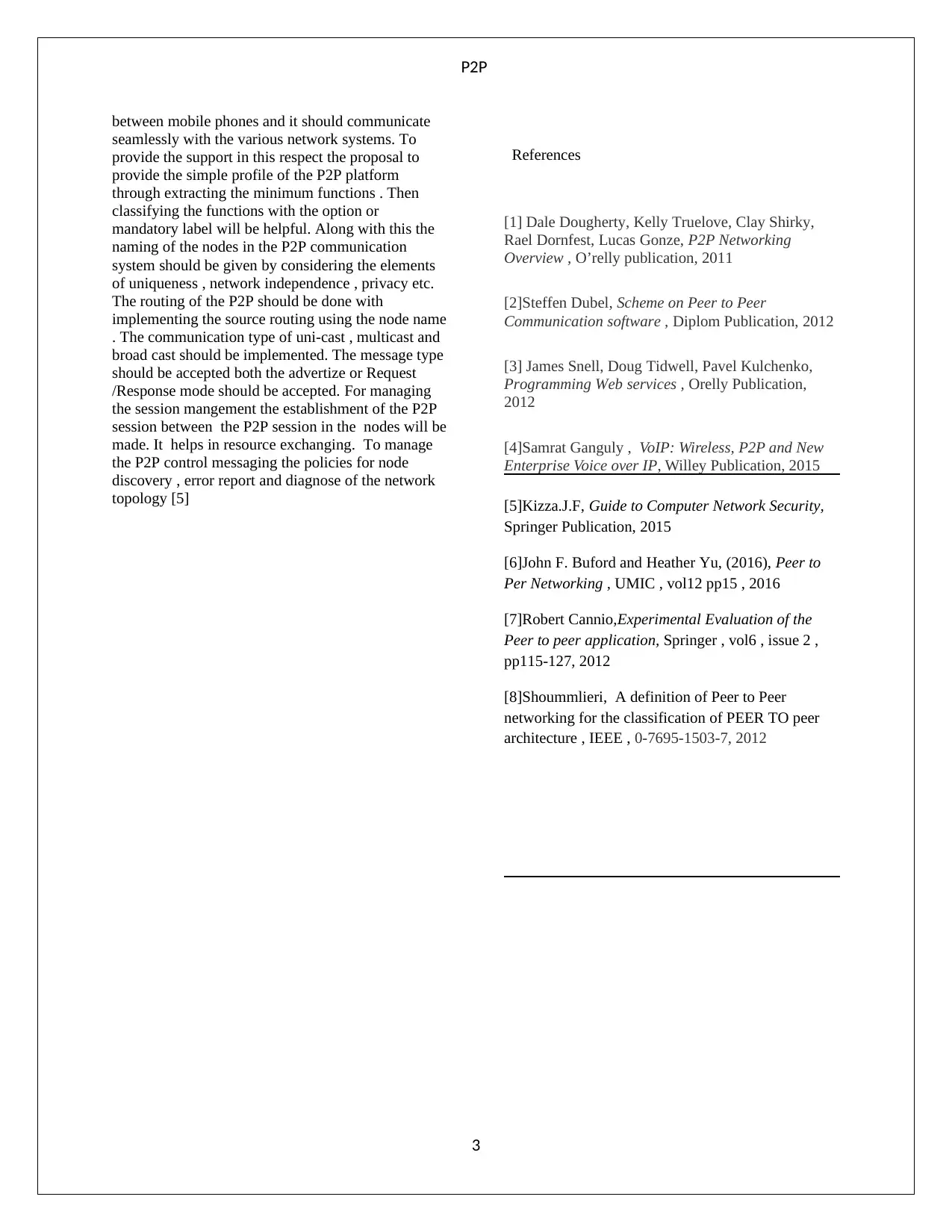Project: Development of UX Design Protocols for a P2P Platform
VerifiedAdded on 2023/01/18
|4
|1268
|93
Project
AI Summary
This project delves into the development of UX design protocols for a P2P software platform, specifically focusing on the Cuuble platform designed for social interaction and care management for older adults. The assignment begins with a literature review of peer-to-peer (P2P) communication systems, highlighting their architecture, advantages, and applications in mobile environments. It discusses the challenges of P2P communication on mobile devices, including bandwidth limitations and network address translation issues, and the importance of designing lightweight protocols. The project then outlines key features expected in P2P protocols, such as support for heterogeneous environments, seamless connections, and ad-hoc communication. The solution emphasizes the need for unique node naming, source routing, and the implementation of various communication types. The project aims to provide a framework for designing user-friendly and efficient P2P software, considering the specific needs of the Cuuble platform to facilitate better connectedness and social interaction for its users. The solution also provides references to relevant research papers and publications.

P2P
Development of UX design protocols for a P2P software platform
1
Development of UX design protocols for a P2P software platform
1
Paraphrase This Document
Need a fresh take? Get an instant paraphrase of this document with our AI Paraphraser

P2P
Literature review
The Peer –to-Peer communications have
become one of the most applied mode of
communication in the communication technology.
The result of its application has shown that it is very
convenient for using as the convenient
communication architecture for the wired network
system. Though it is convenient to use but it cannot
be effectively used for the mobile systems such as
advanced mobile phones, laptop and devices that use
the embedded technology. The most important
feature of the P2P system is that in it each node acts
as server as well as client and it helps in sharing the
data stream with others. There are many P2P
applications that are widely used in the mobile
applications such as IM, VOIP, File Sharing, and
social network system and also in the video
streaming. The introduction of the facility of the Wi-
Fi direct protocol in the existing wireless
technologies has enabled the P2P to use it various
applications. The current researches in the area of
the Peer –to-communication has shown various
theories and examples that has shown the use of Peer
–to-Peer communication protocol and application has
become a solution of a wide number of application in
the field of the communication to share their own
content either in form of text , audio, video etc[1].
This advanced communication system
provides a distributed communication system
architecture that provides the facility of portioning
the task or work -loads between the peers. Each peer
in this system has equal privilege and is equal
participant in the application. They form a peer-to-
peer network mode in the communication system.
This peer provides the facility of making the portion
of the resources for example the processing power,
disk storage or network bandwidth etc. Along with
this it also provides the capability to directly support
the other network participants without any need for
central coordination of the other network system.
Along with sharing the data resources the Peer-to
Peer communication system provides the facility to
work in the Virtual communication system too. The
research is going on to provide the peers the
capability to work in same manner as individual peer
in a group. A typical example of transfer of data over
the network through the Peer to Peer system such as
File transfer system on the network system[3].
The Unstructured Peer-to-Peer communication
system does not specify a particular type of network
design to follow. It is created in the random order as
per the requirements. Due to this feature the
unstructured Peer –to-Peer communication system
are easy to design as it allows the facility of local
optimization of the different regions of overlay. But
the unstructured Peer-to Peer communication system
is highly robust in nature. On the other hand the
structured peer-to-peer communication has a specific
topology oriented network system in which the
protocols ensure that each node in this system can
efficiently search the file in the network
system even in case of limited resources[6].
Another important feature of this communication
system is that it also provides the facility of
connecting in a short distance of the Wi-Fi direct,
IEEE 802.1, Blue tooth or Zing Bee can be connected
in absence of internet too. The capability of the
features provided through the P2P technology has
enabled the technology to support the various group
of people either it be scientific, technical, political,
artistic approach of persons. The architecture of the
P2P has provided the facility of achieving the high
level of scalability, extensibility and efficient
distributed approach in comparison of the tradition
network architecture system. Peer –to- Peer
communication system mobile communication
system depends on the various radio technologies
such as Wi-Fi, Bluetooth etc. But along with this the
designing of P2P service for a mobile device
depends on the lightweight operating system of the
device[2].
Though mobile services has been provided a
great support through P2P communication system
but there are various challenges that are required to
be faced in this process , these challenges such as it is
evident that mobile devices have limited bandwidth,
processing capacity and battery life in comparison to
desktop devices. Along with this the Network address
translator (NAT) and Firewall also put a big
challenge for communication to the paradigm of Peer
–to-Peer communication system.[8]
Some of the popular service in this
communication system are Gnutella , skype are
widely used in the VOIP , File Sharing , group ware
etc. A general P2P Platform is widely used for
various applications. Some key features that is
expected to be provided in the Protocols for the P2P
system are such as support to link the heterogeneous
environment that realize the seam less connection
between various devices and is independent of the
devices. A suitable approach given in this respect is
to join the P2P network with the proxy server. Along
with this it is also expected that the protocols should
support the communication on the ad-hoc
[7]environment too to have the P2P communication
2
Literature review
The Peer –to-Peer communications have
become one of the most applied mode of
communication in the communication technology.
The result of its application has shown that it is very
convenient for using as the convenient
communication architecture for the wired network
system. Though it is convenient to use but it cannot
be effectively used for the mobile systems such as
advanced mobile phones, laptop and devices that use
the embedded technology. The most important
feature of the P2P system is that in it each node acts
as server as well as client and it helps in sharing the
data stream with others. There are many P2P
applications that are widely used in the mobile
applications such as IM, VOIP, File Sharing, and
social network system and also in the video
streaming. The introduction of the facility of the Wi-
Fi direct protocol in the existing wireless
technologies has enabled the P2P to use it various
applications. The current researches in the area of
the Peer –to-communication has shown various
theories and examples that has shown the use of Peer
–to-Peer communication protocol and application has
become a solution of a wide number of application in
the field of the communication to share their own
content either in form of text , audio, video etc[1].
This advanced communication system
provides a distributed communication system
architecture that provides the facility of portioning
the task or work -loads between the peers. Each peer
in this system has equal privilege and is equal
participant in the application. They form a peer-to-
peer network mode in the communication system.
This peer provides the facility of making the portion
of the resources for example the processing power,
disk storage or network bandwidth etc. Along with
this it also provides the capability to directly support
the other network participants without any need for
central coordination of the other network system.
Along with sharing the data resources the Peer-to
Peer communication system provides the facility to
work in the Virtual communication system too. The
research is going on to provide the peers the
capability to work in same manner as individual peer
in a group. A typical example of transfer of data over
the network through the Peer to Peer system such as
File transfer system on the network system[3].
The Unstructured Peer-to-Peer communication
system does not specify a particular type of network
design to follow. It is created in the random order as
per the requirements. Due to this feature the
unstructured Peer –to-Peer communication system
are easy to design as it allows the facility of local
optimization of the different regions of overlay. But
the unstructured Peer-to Peer communication system
is highly robust in nature. On the other hand the
structured peer-to-peer communication has a specific
topology oriented network system in which the
protocols ensure that each node in this system can
efficiently search the file in the network
system even in case of limited resources[6].
Another important feature of this communication
system is that it also provides the facility of
connecting in a short distance of the Wi-Fi direct,
IEEE 802.1, Blue tooth or Zing Bee can be connected
in absence of internet too. The capability of the
features provided through the P2P technology has
enabled the technology to support the various group
of people either it be scientific, technical, political,
artistic approach of persons. The architecture of the
P2P has provided the facility of achieving the high
level of scalability, extensibility and efficient
distributed approach in comparison of the tradition
network architecture system. Peer –to- Peer
communication system mobile communication
system depends on the various radio technologies
such as Wi-Fi, Bluetooth etc. But along with this the
designing of P2P service for a mobile device
depends on the lightweight operating system of the
device[2].
Though mobile services has been provided a
great support through P2P communication system
but there are various challenges that are required to
be faced in this process , these challenges such as it is
evident that mobile devices have limited bandwidth,
processing capacity and battery life in comparison to
desktop devices. Along with this the Network address
translator (NAT) and Firewall also put a big
challenge for communication to the paradigm of Peer
–to-Peer communication system.[8]
Some of the popular service in this
communication system are Gnutella , skype are
widely used in the VOIP , File Sharing , group ware
etc. A general P2P Platform is widely used for
various applications. Some key features that is
expected to be provided in the Protocols for the P2P
system are such as support to link the heterogeneous
environment that realize the seam less connection
between various devices and is independent of the
devices. A suitable approach given in this respect is
to join the P2P network with the proxy server. Along
with this it is also expected that the protocols should
support the communication on the ad-hoc
[7]environment too to have the P2P communication
2

P2P
between mobile phones and it should communicate
seamlessly with the various network systems. To
provide the support in this respect the proposal to
provide the simple profile of the P2P platform
through extracting the minimum functions . Then
classifying the functions with the option or
mandatory label will be helpful. Along with this the
naming of the nodes in the P2P communication
system should be given by considering the elements
of uniqueness , network independence , privacy etc.
The routing of the P2P should be done with
implementing the source routing using the node name
. The communication type of uni-cast , multicast and
broad cast should be implemented. The message type
should be accepted both the advertize or Request
/Response mode should be accepted. For managing
the session mangement the establishment of the P2P
session between the P2P session in the nodes will be
made. It helps in resource exchanging. To manage
the P2P control messaging the policies for node
discovery , error report and diagnose of the network
topology [5]
References
[1] Dale Dougherty, Kelly Truelove, Clay Shirky,
Rael Dornfest, Lucas Gonze, P2P Networking
Overview , O’relly publication, 2011
[2]Steffen Dubel, Scheme on Peer to Peer
Communication software , Diplom Publication, 2012
[3] James Snell, Doug Tidwell, Pavel Kulchenko,
Programming Web services , Orelly Publication,
2012
[4]Samrat Ganguly , VoIP: Wireless, P2P and New
Enterprise Voice over IP, Willey Publication, 2015
[5]Kizza.J.F, Guide to Computer Network Security,
Springer Publication, 2015
[6]John F. Buford and Heather Yu, (2016), Peer to
Per Networking , UMIC , vol12 pp15 , 2016
[7]Robert Cannio,Experimental Evaluation of the
Peer to peer application, Springer , vol6 , issue 2 ,
pp115-127, 2012
[8]Shoummlieri, A definition of Peer to Peer
networking for the classification of PEER TO peer
architecture , IEEE , 0-7695-1503-7, 2012
3
between mobile phones and it should communicate
seamlessly with the various network systems. To
provide the support in this respect the proposal to
provide the simple profile of the P2P platform
through extracting the minimum functions . Then
classifying the functions with the option or
mandatory label will be helpful. Along with this the
naming of the nodes in the P2P communication
system should be given by considering the elements
of uniqueness , network independence , privacy etc.
The routing of the P2P should be done with
implementing the source routing using the node name
. The communication type of uni-cast , multicast and
broad cast should be implemented. The message type
should be accepted both the advertize or Request
/Response mode should be accepted. For managing
the session mangement the establishment of the P2P
session between the P2P session in the nodes will be
made. It helps in resource exchanging. To manage
the P2P control messaging the policies for node
discovery , error report and diagnose of the network
topology [5]
References
[1] Dale Dougherty, Kelly Truelove, Clay Shirky,
Rael Dornfest, Lucas Gonze, P2P Networking
Overview , O’relly publication, 2011
[2]Steffen Dubel, Scheme on Peer to Peer
Communication software , Diplom Publication, 2012
[3] James Snell, Doug Tidwell, Pavel Kulchenko,
Programming Web services , Orelly Publication,
2012
[4]Samrat Ganguly , VoIP: Wireless, P2P and New
Enterprise Voice over IP, Willey Publication, 2015
[5]Kizza.J.F, Guide to Computer Network Security,
Springer Publication, 2015
[6]John F. Buford and Heather Yu, (2016), Peer to
Per Networking , UMIC , vol12 pp15 , 2016
[7]Robert Cannio,Experimental Evaluation of the
Peer to peer application, Springer , vol6 , issue 2 ,
pp115-127, 2012
[8]Shoummlieri, A definition of Peer to Peer
networking for the classification of PEER TO peer
architecture , IEEE , 0-7695-1503-7, 2012
3
⊘ This is a preview!⊘
Do you want full access?
Subscribe today to unlock all pages.

Trusted by 1+ million students worldwide

P2P
4
4
1 out of 4
Related Documents
Your All-in-One AI-Powered Toolkit for Academic Success.
+13062052269
info@desklib.com
Available 24*7 on WhatsApp / Email
![[object Object]](/_next/static/media/star-bottom.7253800d.svg)
Unlock your academic potential
Copyright © 2020–2025 A2Z Services. All Rights Reserved. Developed and managed by ZUCOL.





